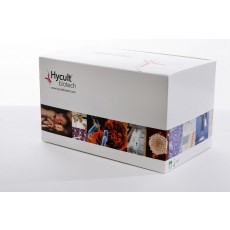MGO, Competitive ELISA
- Supplier: Hycult Biotech
Product Description
- Glycation, or nonenzymatic glycation, is the nonenzymatic reaction of glucose and other reducing sugars with free amino groups of proteins, lipids and nucleic acids. The amino groups of the side chains of arginine and lysine are the primary targets for this type of modification. Over time, the initial glycation products may undergo intramolecular rearrangements and oxidation reactions (glycosidation) and ultimately transfrom in stable, so-called advanced glycation end products (AGEs). Several compounds, e.g. NƐ-carboxymethyl-lysine (CML), pentosidine, or methylglyoxal (MGO) derivates, serve as examples of well-characterized and widely studies AGEs. _x000D_
- AGEs have the potential to interact with a specific receptor (RAGE), a member of the immunoglobulin superfamily, initiating signal pathways that amplify infammation and oxidative stress, and thereby leading to cellular injury and death. High levels of circulating AGEs are associated with cardiovascular disease, diabetes, chronic kidney disease, and increased mortality. _x000D_
- MGO is a highly reactive dicarbonyl metabolite formed during glucose, protein and fatty acid metabolism. Several nonenzymatic as well as enzymatic reactions are involved in MGO formation. MGO can be formed by nonenzymatic elimination of phoshate from triose phosphates, glyceraldehyde-3-phosphate and glycerone phosphate, as well as enzymatically from dihydroxyacetone phosphate by MGO synthase. MGO reacts with protein by initial reversible reactions: with arginine and lysine residues forming glycosylamine, with cysteine forming hemithioacetal. The irreversible reaction of MGO with lysine residues of protein forms NƐ-carboxyethyl-lysine (CEL), NƐ-carboxymethyl-lysine (CML) and 1,3-di(N-lysino)-4-methyl-imidazolium (MOLD). MGO reacts with arginine residues of protein to form the non-fluorescent products argpyrimidine and hydroxyimidazolone. _x000D_
- MGO-induced AGEs have been linked to the aging process and age-related diseases such as cardiovascular complications of diabetes, neurodegenerative disease and connective tissue disorders. Furthermore, MGO levels are elevated in hyperglycemia and has been implicated in hypertension and atherosclerosis._x000D_
- The MGO assay can be used to measure MGO-adducts as HSA-MGO arbitrary units. In normal citrate plasma ~200-400 AU/ml can be measured.
- The competitive MGO ELISA kit is to be used for in vitro quantitative determination of MGO in plasma and faeces samples
Resources
Product Options
| Product Number | Description | Package Size | List Price (CAD) | ||
|---|---|---|---|---|---|
| HYBHIT503 | MGO, Competitive ELISA | 1 x 96 det. | -- | Add to Cart |
List Prices are displayed.
Please register or log-in to the site to view your organization’s prices, or please add the products to your cart and click the “Request a Quote” button to receive price and availability information (include quantities for each product and indicate either a one-time purchase or your annual usage.)



